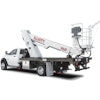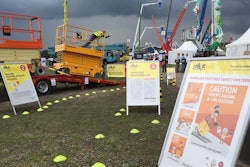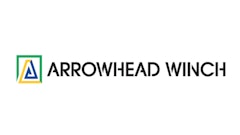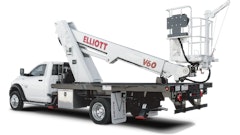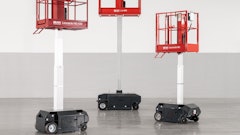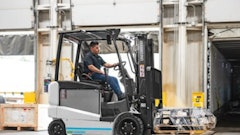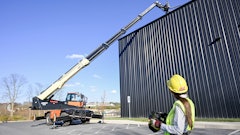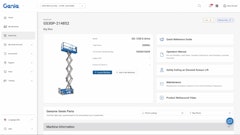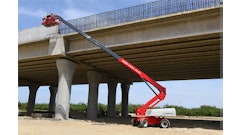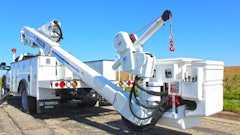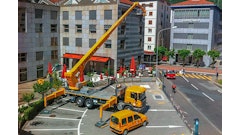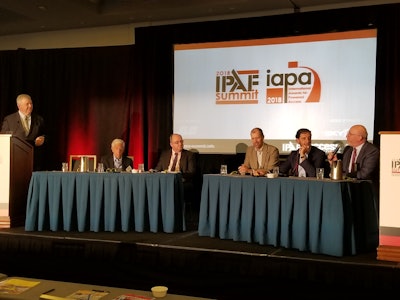
No one can argue the world is changing very fast, on every level, and the rental and powered access industries are no exception. From equipment technology to training methods to the equipment operators themselves, nothing remains static. And for those who make their living from the sale, rental or use of powered access equipment, it’s fascinating to consider what direction the industry will take next. These matters were discussed by a panel of experts at the IPAF Summit in Miami last spring; following is an excerpt.
Editor’s note: Comments have been edited for space and clarity.
Andy Studdert, former CEO, NES Rentals: What do think will be the biggest change in the powered access industry over the next 10 years?
Norty Turner, CEO, Riwal: I think construction in 2028 will be very much autonomous. We’ll get there in stages, but the design of how a construction project comes together, and how we will build will be increasingly important. There’s a lot of disruption coming, and it will bring a tremendous opportunity for the powered access industry.
Pedro: (awaiting translated comments)
Michael Kneeland, CEO, United Rentals: I’m a day dreamer, so hold on here, but I think between the internet of things and artificial intelligence, we’re going to see a change in the way we approach our business and particularly, the customer. They’re putting sensors into almost everything that is possible now. They’re putting them in dry wall, just to determine temperature and moisture. They’re putting them in your clothing. So as machines take in information and learn, artificial intelligence will help us help our customers do better, quicker, safer… and I think for us, we have to be prepared to incorporate that into our daily business.
Dan Kaplan, CEO, Daniel Kaplan Associates: We’ll see a total change in the rental industry in 10 years. It will be dominated by extremely large players and a severe reduction of independents. Small companies located within a 15-miles radius of a national chain outlet stand no chance. They won’t be able to compete with the national accounts, who will offer pricing and service that nobody can match… they’ll be so sophisticated, so good.
It’s not going to be simple. You’re going to have to bring up the standards of what you’re doing to compete. The question is whether you can get to those standards unless you’ve got scale. Scale really matters. And you have to have the money to get there.
Nick Selley, group business development director, AFI, and president of IPAF: I take a slightly contrarian view. I think there will be significant change, but I also think the services actually delivered will have to change. The population is changing, and a lot of people are now very comfortable using the internet. Uber is a classic example… how it’s disrupted the taxi market. The rental industry potentially may suffer the same fate, to some degree. How that will happen I’m not entirely certain at this point, but I think we have to be prepared that the traditional models we’ve all enjoyed that have remained fairly static will have to change and adapt to customer behavior.
Studdert: What will be the major disrupters?
Turner: I feel the way things will be built is going to be different. Technology that enables 3D printing, for example. Obviously, there will still be work done at height; jobs won’t change, the solutions will. So the solutions that will come down the pike, as far as access in construction, will be disruptive. I’m not suggesting access will go away, but the way things are built is changing. I think robotics are going to be disruptive but they will also provide an opportunity for us as well. In the future there will be boom lifts that don’t have a basket, just a robotic tool with arms on the end to put things in place.
Pedro: XXXXXX
Kneeland: From a disruption standpoint, I don’t think we really know yet. For one thing, we have multi-generational customers. We’ve got Joe, who wants to sit down to lunch and talk it over, and then you’ve got Bob, a technical guy who wants information fed straight to his computer so he can make decisions. Then you’ve got the millennials, who really don’t want to talk to anyone, unless they’ve got a problem, and they want to be in control of all of it. I think we have to sit back and ask, are we experimenting enough?
I look at the rental industry as a disrupter. Yes, construction is going to change, technologies are going to change. I also think we need to be able to disrupt ourselves, and do something completely different and unheard of. I think over time, we’ll evolve, and the rate of change is getting exponentially faster. At United, we want to be like Uber. We’re running some processes that are trying to break the mold, but we haven’t gotten there yet.
If you think about Uber for a moment… What they did was tackle the pain point of trying to find a taxi when it’s either hot, cold, or soaking wet, and then dealing with the payment process. It offered complete simplicity and that’s what they sold, and it made them grow so fast.
Selley: It’s about finding a big mechanism that makes it easier to transact. One of the benefits of Uber is they offer an easily quantifiable service. In rental, we’re renting a very expensive asset and we’ve got to do a credit check because we won’t give a $100,000 unit out to just anyone. There’s a defined risk, we know what the cost is, but renting on a weekly basis costs a fraction of the actual acquisition cost. I’ve not seen any model to transact something like this on an ecommerce basis that fully works. I know United has got a system, I know we have got a system, but the industry still has a long way to go.
Andy: That’s true, our transactions are a bit more complicated than pick up and drop off.
Euan Youdale, editor of Access International: How will the manufacturing sector look in 10 years with so many new players coming into the industry. What effect they will have?
Turner: I was at Bauma China a couple years ago, and there were 106 Chinese aerial work platform manufacturers. It’s been a growing industry since I started in 1995 and it brings in a lot of different players. The maturity arc of our industry continues to progress and as it does mature, that will drive more consolidation from manufacturers. Those that will be strong in 10 years will be those that will innovate, and how they go about innovation is critical. Again, jobs don’t change, the solutions do. The ability to understand those jobs and bring forth innovative solutions will dictate success.
Kneeland: We’re on the cutting edge of what’s possible. Even the futuristic “exosuits” you see, where you’re like a robot, are already real, the military uses them, and metal facilities are using them. I could easily see a hover craft coming as a form of access. I’m sure the military is doing something very similar to that already, to elevate their people. Drones are another way of elevating things, and moving materials around. We have to be cognizant of what technology is out there and challenge ourselves. It’s not only the manufacturers.
Pedro: XXXXXXX
Tim Whiteman, CEO, IPAF: IPAF represents the interests of small, medium and large rental companies and manufacturers. If I were just starting up a small rental company focused on aerials, I’d be pretty depressed to hear it’s all about scale, scale, scale. And yet, there are companies out there who continue to be successful. What advice would you give me about starting up a MEWP rental business?
Turner: Get good access to capital because you’re going to need a lot if you’re going to compete. Great people are also critical. These are pretty basic things but without them, you won’t succeed. The rental business takes a lot of capital - we don’t make one dime until we buy a rental fleet - so that’s absolutely critical. And then how you go about knowing your customer, and how you incorporate digital technology to get to know your customer is going to be absolutely critical.
Selley: Scale is one way to go, but the market has always been relatively fragmented. You either have to be small and/or relatively niche, or go for significant scale. The problem is there is no middle ground. Once you go to the middle ground, you need the infrastructure within the organization, which is non-revenue generating, to support the net worth that you’ve built. You almost have to be a 1-2 depot operation, and keep your small niche and stay local, the mom and pop type, or you have to be a rental company of scale.
Question – Maria Hadlow, editor of Lift & Hoist International: We’ve been focused on construction, but do you see any changes in the use of aerial work platforms in industrial markets in the US over the next 10 years? Will that market grow or cease to exist?
Kneeland: When I think about what it is that we really do, it comes down to safety and productivity. I think aerial work platforms have plenty of life left in the industrial sector in a lot of ways. To start with, a lot of industrial companies still own their assets and we know they don’t utilize them to the extent that they should. So it’s really a waste on their balance sheet and I think there’s a growth opportunity there. Again, it comes down to safety and productivity. It will evolve, and as long as we can communicate what those needs are, and then invest in them, there will be more opportunities. Clearly, there’s a market in the industrial sector, with plenty of legs left.
Turner: There’s a real focus on safety in construction, and my experience is the focus is even higher in the industrial sector. As technology comes forth with robotics and so on, and we have the ability to get a person out of harm’s way, aerial work platforms will be fully embraced in industry. The industrial sector is also a more predictable environment, much more so than construction. If we have the ability to adopt some of those technologies that rely more on controlled environments, the potential in that market will be even greater.
Studdert: 10 years from now, what talents will be required from executives to run these companies? What will be different from the talents that are required today?
Kneeland: We have generational gaps and we need to understand those dynamics in the rental business. We all can buy equipment, but it really comes down to your people, and the processes you have in place, to define who you are. A new leader needs to understand the generational gaps and how they can help you, and how they can hinder you. You have to be active listening and open minded, much more so now because there has been a leap, a whole generation that grew up studying and working on a computer and playing games on a screen. Their social life is nothing like the social life I had growing up, it’s completely different. As a result, they have different needs. They need to be purpose driven, for one thing. They ask, the company I’m going to work for, what does it mean? How does it contribute to a better society? That’s very important for that group. A new leader has to really understand that things are moving fast and they have to be able to adapt and listen, really listen. If they can’t, they’re going to wake up one day and not have a whole lot of people around.
Turner: We are all digital immigrants up on this panel. The digital natives are going to assimilate into power and they’re going to take the exec positions. Those executives that are going to be able to manage change - be change agents, change champions - are going to be really critical. Things are changing fast now, by 2030 it’s going to be lightning fast.


